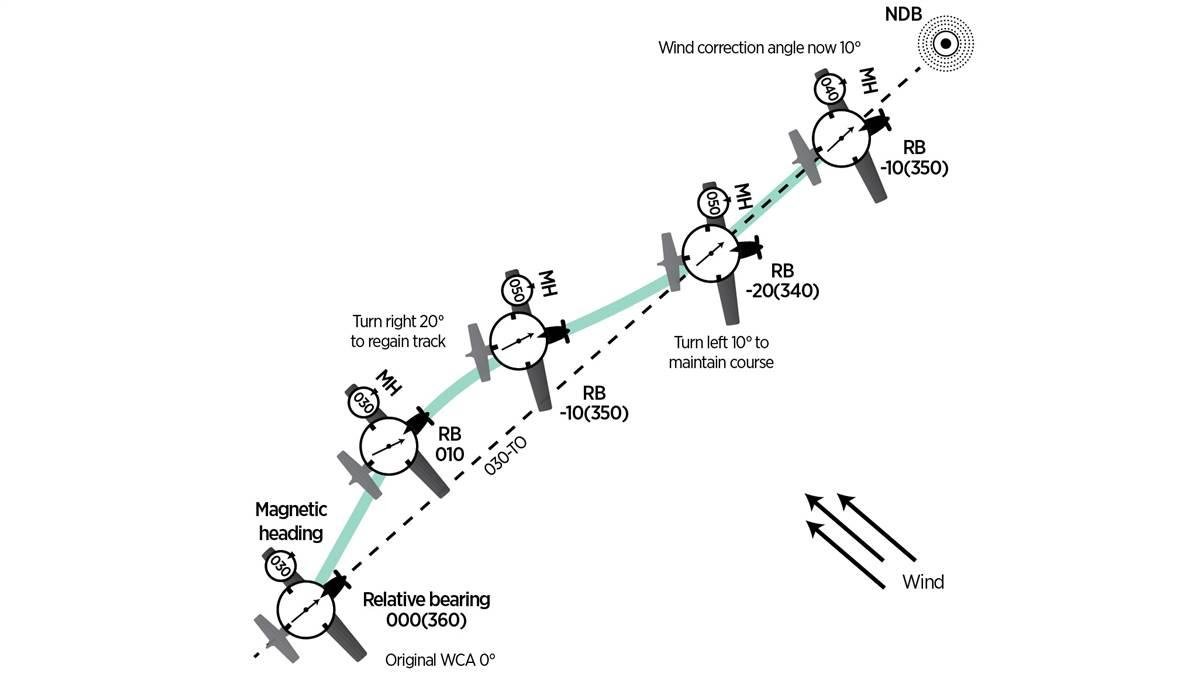The dreaded NDB
Every pilot should have a nodding acquaintance

But not all airplanes have wall-to-wall glass cockpits without ADFs. Many older airplanes—the bulk of the general aviation fleet—are still flying around with ADFs, those with radio magnetic indicators (RMIs, which are also paired with VORs) have them, and many ILS approaches still use compass locaters as final approach and other fixes, and these can be considered NDBs. There are even some NDB approaches serving airports in the United States. Going to Canada or overseas? You’ll find there are plenty of NDBs at work as approach or enroute fixes.
We can’t go into vast detail about NDBs (the ground stations) and ADFs (the cockpit instruments used to track their bearings) in this space, but it’s still worthwhile to review the basics. If you fly behind one, you really ought to know how it works. And you never know, some day you might find yourself—gasp!—needing to shoot an NDB approach some dark and stormy night.

The main principle behind ADFs is that they always point to the station. It’s a simple matter to fly directly to an NDB. Turn the airplane so that the ADF needle points straight ahead, and fly toward it. If there’s a crosswind, you’ll see the needle drifting to one side or the other, so to correct for a crosswind you’ll have to track your way to the station by turning into the wind and trying a new heading. If there’s a 10-knot crosswind component, try turning 20 degrees to reintercept your course, then wait until you’re crabbed 10 degrees to counteract the crosswind. You’ll be on course when the angle of the ADF needle equals the amount of heading correction you made. This works for tracking to the station.
To track from the station with a crosswind, the same principle applies. But this time the station is behind you, and you’ll have to turn the airplane so that your heading moves toward the deflected ADF needle. Let’s say you have a 20-knot crosswind. The needle deflects 20 degrees, you turn toward it, and you’re back on course when the needle settles at 20 degrees off the tail. Turn the airplane so as to hold that correction angle, and off you go.

On an NDB approach, you’re expected to track a specific bearing to or from the station to reach the missed approach point. How do you locate that bearing? By turning to a heading that matches the final approach course—paralleling the course, in other words—and checking the ADF needle’s deflection. Let’s say it’s 10 degrees. Turn toward the needle with a 20-degree heading change. Hold that heading until the needle deflection is 10 degrees off te (or tail) of the ADF indicator’s 12 o’clock or six o’clock position, then turn the airplane back on course. If the needle deflection stays the same, you’re on course, correcting for the crosswind, and tracking inbound or outbound on the desired bearing.
If you’re being vectored toward an ILS with a compass locator, The ADF is great for giving you a mental picture of its location. You can watch the ADF point to the locator as you’re being turned onto final, or sent farther away if you’re being sequenced behind other traffic. You can also watch as the needle flips from front to rear as you fly over the locator.
The main principle behind ADFs is that they always point to the station. It’s a simple matter to fly directly to an NDB. Turn the airplane so that the ADF needle points straight ahead, and fly toward it.There are other nice-to-know features. Want to know how long it will take to fly to the NDB? Turn the airplane to put the ADF needle on the instrument’s 45- or 315-degree position. Mark your time. Maintain your heading until the needle is at the 090- or 270-degree position. Mark your elapsed time. This is the time needed to fly to the station. It’s called the “double the angle” or “bow to beam” method for getting an ETA to the station.
Other NDB procedures can be more vexing. Like flying a holding pattern using an NDB as a holding fix. Here, you’ll be flying both inbound and outbound legs, correcting for any wind on each, plus timing each leg and turn based on either the NDB’s passage or elapsed time on the outbound leg. It can be workout! But for that matter, I’ve heard some pilots call tracking an NDB approach using an outbound bearing an “emergency” procedure. They’re kidding of course, but not by much. You can fly to or from an NDB just by turning to keep the ADF needle on the instrument’s nose or tail. That’s kind of cheating, because this is homing—not the tense tracking your instructor would like to see you fly. In a hurricane crosswind, of course. Just kidding.
Then again, I’ve heard high-time pilots argue that homing on the two- to three-minute final approach path isn’t much different than tracking. Any errors in track will be minor over a distance that short, they say. Just keep an eye peeled for the runway when your time’s up. It may be well off to one side or the other.
Of course, we’ve all heard that the NDB receiver is useful as a way of listening to sports events, music, or talk shows. That’s true, because NDBs use the same AM frequency band as the one in your car radio. They can be strong, too—until you fly out of range or the station signs off for the night. So for most of us, today’s NDBs see duty as a “supplemental” navaid for use in VFR flying only. And to nearly everyone’s gratitude, you no longer have to demonstrate your NDB skills on checkrides.



